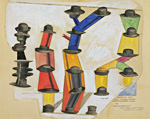 Cnn website relates that the Massachusetts Institute of Technology (Mit) has a new wireless network — extended to cover the entire campus — providing information on exactly how many people are logged on at any given location at any given time. It even reveals a user’s identity if the individual has opted to make that data public. Mit researchers did this by developing electronic maps that track across campus, day and night, the devices people use to connect to the network. The map that can pinpoint locations in rooms is 3-d, so researchers can even distinguish connectivity in multistoried buildings. It seems to be the beginning of real-time 3-d information available for diverse users.
Cnn website relates that the Massachusetts Institute of Technology (Mit) has a new wireless network — extended to cover the entire campus — providing information on exactly how many people are logged on at any given location at any given time. It even reveals a user’s identity if the individual has opted to make that data public. Mit researchers did this by developing electronic maps that track across campus, day and night, the devices people use to connect to the network. The map that can pinpoint locations in rooms is 3-d, so researchers can even distinguish connectivity in multistoried buildings. It seems to be the beginning of real-time 3-d information available for diverse users.
Researchers in social science, among such users, note that such data could be used to reach a better understanding of the impact of wireless technology on campus life, providing means for spatial planning which does take such an impact into account.
The field of such a research might soon be extended. ‘Many cities, including Philadelphia, are planning to go wireless. Something like our study will help them understand usage patterns and where best to invest’ said researcher Andres Sevtsuk. ‘Instead of waiting every year or every 10 years for data, you have new information every 15 minutes or so about the population of the campus’ he said. Such real-time map monitoring of cities and spaces might open new epistemological perspectives in social sciences.
But not everyone is happy: ‘I wouldn’t want all my friends and professors tracking me all the time. I like my privacy’ a Mit student said. ‘I can’t think of anyone who would think that’s a good idea. Everyone wants to be out of contact now and then’.
The event thus raises two questions addressed to the social sciences. Firstly, what means and methods of interpretation can be conceived in the perspective of dealing with ever more precise space-time data? Secondly, the moment seams to have come to weight once again the interests of science, with its rising needs of such data, against the interests of individuals, with their lasting need of privacy.
Read the article on the Cnn website.
Image: Max Ernst. The Hat Makes the Man. (1920) © 2005 Artists Rights Society, New York / Adagp, Paris.
